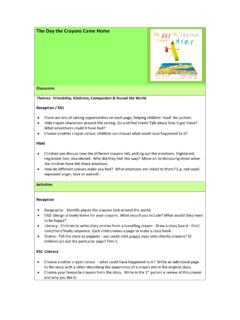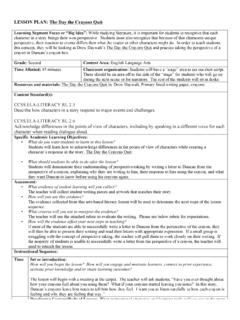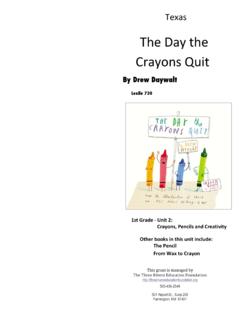Transcription of OLIVER JEFFERS DISCUSSIONS AND ACTIVITIES
1 OLIVER JEFFERS DISCUSSIONS AND ACTIVITIES We have been working with teachers to develop a range of ideas for you to use with the following OLIVER JEFFERS picture books across Reception, KS1 and KS2. The titles include The Incredible Book Eating Boy, The Day the crayons Came Home, Imaginary Fred and A Little Stuck. The Incredible Book Eating Boy Discussion Reading for pleasure A great book for promoting reading for pleasure. Share quotes about reading what are they telling you? Discuss characters and settings that have been enjoyed. Great opportunity to share favourite books and make recommendations. Library skills Dewey Decimal System could be explored at KS2.
2 PSHE (KS2) Henry goes through three big changes: two positive (becoming smarter and smarter; finding a new love for reading) one negative (losing his smarts). Discuss how he feels at different points of the story. Consider his confidence. When and why does it change? Share times in your own life when you have experienced a big change (especially useful around school transition times) and how this has made you feel. What does Smart mean? Discuss children s perception of what smart means. Henry is called smart because he know the answers to lots of questions. Is this what it means to be smart? Look at the smart characters in books.
3 How are they labelled by the author? Good/bad, popular/unpopular ACTIVITIES Reception Work in healthy eating choices. You don t need to eat books! What things help your body to grow fit and healthy? Create a healthy food choice plate collage. Use tissue paper etc and glue to plate. Children can then label the foods. (Personal Development) So Henry believed eating books would make him smarter! I wonder what would happen if we decided to eat lots of just one thing? Draw/Paint a picture showing yourself eating lots of what? Create a caption for it. Why did you choose that? What super skill would it give you? Storyboard it. (Literacy) KS1 Creating a Book restaurant write a Menu of books and what you will get out of eating them.
4 Creating a Healthy book eating / reading lifestyle. Link in with healthy eating. I love chocolate, Cakes and crisps and if I eat them all the time I would not be well what advice could you give Henry to keep a healthy book lifestyle? Creating the Smart Readers guide what books will make you smart? KS2 Science (Healthy Eating You are what you eat) Henry becomes unwell because he is only eating books. Investigate healthy eating food groups, vitamin and minerals. What should a person eat to stay fit and healthy. This could be extended in to cooking: children could come up with a menu for Henry (one meal or even breakfast, lunch and dinner) to try to tempt Henry away from his book-eating habits.
5 This could then be cooked and shared (cross curricular link with maths for measures, ratio, etc). Henry s body cannot digest the books properly. Study the digestive system: What can the human body digest? What is left at the end? How does the body get energy from what is eaten? Children can write an explanation of the digestive system (opportunity for showing passive voice) Spelling, punctuation and Grammar Great for looking at different punctuation colons, elipses and colons, tenses past pefect and simple past, adverbials and sentence types. There is plenty to explore and discuss. English (creative writing) Writing in role: Write in role as Henry at various points of the story when he first tries eating a book, when starts getting smarter, when he becomes ill.
6 This could be extended to writing in role as Henry s best friend, parent or teacher, requiring more inference from the text and imagination. Newspaper article: Incredible Book Eating Boy. An article about Henry at the height of his book-eating. This could also been written as a magazine interview (descriptive opening section with information and background detail and personal opinions/feeling about the meeting followed by questions from the interviewer (the writer) and answers from Henry). Persuasive writing: Write a letter to persuade Henry to read books rather than eat them. This could use evidence from the book as well as the child s own knowledge and thoughts.
7 Poetry: Henry eats a range of different types of books from atlases to dictionaries. What do the different books taste like? Children could look at food descriptions from packaging and menus to get an idea of phrases used and should combine this with the type of book. Each stanza of the poem could describe the taste of a different type of book. Consider and justify (short writing): If you could eat a book like Henry, which one would you eat and why? Biography: use the information in the text to write a chapter of Henry s biography The Book-Eating Years (this could also be done as an autobiography). Formal letter of complaint: Write a letter from the library to Henry, complaining about his book-eating habits Resource created by Torie Walton, Marie Berry and Lynnette Voisey for The Day the crayons Came Home Discussion Themes: Friendship, Kindness, Compassion & Round the World Reception / KS1 There are lots of talking opportunities on each page, helping children read the picture.
8 Hide crayon characters around the setting. Go and find them! Talk about how it got there? What adventures could it have had? Choose another crayon colour; children can discuss what could have happened to it? PSHE Children can discuss how the different crayons felt, picking out the emotions: frightened, neglected, lost, abandoned. Why did they feel this way? Move on to discussing times when the children have felt these emotions. How do different colours make you feel? What emotions are linked to them? red could represent anger, love or warmth. ACTIVITIES Reception Geography: Identify places the crayons visit around the world. EAD: Design a lovely home for your crayons .
9 What would you include? What would they need to be happy? Literacy: Children to write diary entries from a travelling crayon. Draw a story board - first/ next/then/finally sequence. Each child creates a page to make a class book. Drama: Tell the story as puppets - you could stick goggly eyes onto chunky crayons ? Or children act out the particular page? Film it. KS1 Literacy Choose another crayon colour - what could have happened to it? Write an additional page to the story with a letter describing the experience of a crayon not in the original story. Choose your favourite crayons from the story. Write in the 1st person a review of this crayon and why you like it.
10 Look at a pack of crayons explore what we use each colour for. Children to write a sentence from the point of view of each crayon or a selection of colours: I m red crayon and my job is colouring in the apples and tomatoes Develop work from OLIVER JEFFERS earlier book, The Day the crayons Quit, called The Day the Toys Quit. Take a photo of under a child s bed of the lost toys that are often forgotten. Bring in a toybox and take out the main what are the toys left at the bottom? What is the story of these toys? Children to explore what happens to the lost toys. They can choose a different toy to write a complaint postcard to Duncan about.










